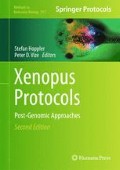Abstract
Proteomic characterization of protein complexes leverages the versatile platform of liquid chromatography-tandem mass spectrometry to elucidate molecular and cellular signaling processes underlying the dynamic regulation of macromolecular assemblies. Here, we describe a complementary proteomic approach optimized for immunoisolated protein complexes. As the relative complexity, abundance, and physiochemical properties of proteins can vary significantly between samples, we have provided (1) complementary sample preparation workflows, (2) detailed steps for HPLC and mass spectrometric method development, and (3) a bioinformatic workflow that provides confident peptide/protein identification paired with unbiased functional gene ontology analysis. This protocol can also be extended for characterization of larger complexity samples from whole cell or tissue Xenopus proteomes.
Access this chapter
Tax calculation will be finalised at checkout
Purchases are for personal use only
References
Washburn MP, Wolters D, Yates JR III (2001) Large-scale analysis of the yeast proteome by multidimensional protein identification technology. Nat Biotechnol 19(3):242–247
Wang H, Chang-Wong T, Tang HY, Speicher DW (2010) Comparison of extensive protein fractionation and repetitive LC-MS/MS analyses on depth of analysis for complex proteomes. J Proteome Res 9(2):1032–1040
Gygi SP, Rist B, Gerber SA, Turecek F, Gelb MH, Aebersold R (1999) Quantitative analysis of complex protein mixtures using isotope-coded affinity tags. Nat Biotechnol 17(10):994–999
Fang X, Zhang WW (2008) Affinity separation and enrichment methods in proteomic analysis. J Proteomics 71(3):284–303
Kocher T, Swart R, Mechtler K (2010) Ultra-high-pressure RPLC hyphenated to an LTQ-Orbitrap Velos reveals a linear relation between peak capacity and number of identified peptides. Anal Chem 83(7):2699–2704
Hossain M, Kaleta DT, Robinson EW, Liu T, Zhao R, Page JS et al (2011) Enhanced sensitivity for selected reaction monitoring mass spectrometry-based targeted proteomics using a dual stage electrodynamic ion funnel interface. Mol Cell Proteomics 10(2):M000062–MCP000201
Olsen JV, Schwartz JC, Griep-Raming J, Nielsen ML, Damoc E, Denisov E et al (2009) A dual pressure linear ion trap Orbitrap instrument with very high sequencing speed. Mol Cell Proteomics 8(12):2759–2769
Olsen JV, Vermeulen M, Santamaria A, Kumar C, Miller ML, Jensen LJ et al (2010) Quantitative phosphoproteomics reveals widespread full phosphorylation site occupancy during mitosis. Sci Signal 3(104):ra3
Moorman NJ, Sharon-Friling R, Shenk T, Cristea IM (2010) A targeted spatial-temporal proteomics approach implicates multiple cellular trafficking pathways in human cytomegalovirus virion maturation. Mol Cell Proteomics 9(5):851–860
Picotti P, Bodenmiller B, Mueller LN, Domon B, Aebersold R (2009) Full dynamic range proteome analysis of S. cerevisiae by targeted proteomics. Cell 138(4):795–806
Selimi F, Cristea IM, Heller E, Chait BT, Heintz N (2009) Proteomic studies of a single CNS synapse type: the parallel fiber/Purkinje cell synapse. PLoS Biol 7(4):e83
Greco TM, Yu F, Guise AJ, Cristea IM (2011) Nuclear import of histone deacetylase 5 by requisite nuclear localization signal phosphorylation. Mol Cell Proteomics 10(2):M110.004317
Kramer T, Greco TM, Enquist LW, Cristea IM (2011) Proteomic characterization of pseudorabies virus extracellular virions. J Virol 85(13):6427–6441
Wenger CD, Phanstiel DH, Lee MV, Bailey DJ, Coon JJ (2011) COMPASS: a suite of pre- and post-search proteomics software tools for OMSSA. Proteomics 11(6):1064–1074
Kall L, Canterbury JD, Weston J, Noble WS, MacCoss MJ (2007) Semi-supervised learning for peptide identification from shotgun proteomics datasets. Nat Methods 4(11):923–925
Keller A, Nesvizhskii AI, Kolker E, Aebersold R (2002) Empirical statistical model to estimate the accuracy of peptide identifications made by MS/MS and database search. Anal Chem 74(20):5383–5392
Nesvizhskii AI (2010) A survey of computational methods and error rate estimation procedures for peptide and protein identification in shotgun proteomics. J Proteomics 73(11):2092–2123
Author information
Authors and Affiliations
Corresponding author
Editor information
Editors and Affiliations
Rights and permissions
Copyright information
© 2012 Springer Science+Business Media, LLC
About this protocol
Cite this protocol
Greco, T.M., Miteva, Y., Conlon, F.L., Cristea, I.M. (2012). Complementary Proteomic Analysis of Protein Complexes. In: HOPPLER, S., Vize, P. (eds) Xenopus Protocols. Methods in Molecular Biology, vol 917. Humana Press, Totowa, NJ. https://doi.org/10.1007/978-1-61779-992-1_22
Download citation
DOI: https://doi.org/10.1007/978-1-61779-992-1_22
Published:
Publisher Name: Humana Press, Totowa, NJ
Print ISBN: 978-1-61779-991-4
Online ISBN: 978-1-61779-992-1
eBook Packages: Springer Protocols

